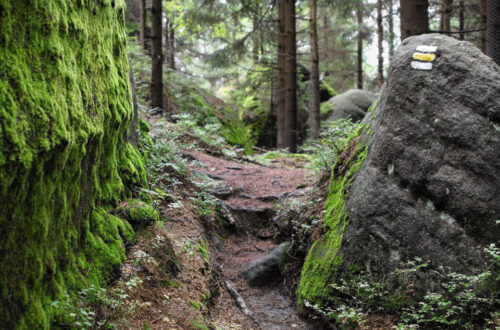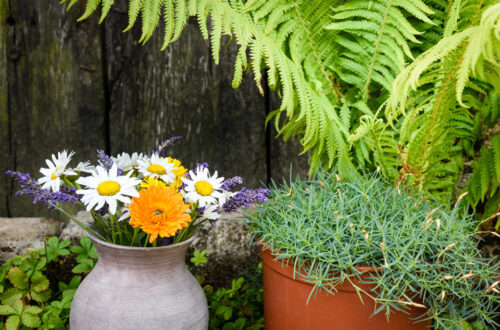My bullet journaling adventure continues
Have you ever heard of bullet journaling?
To put it in a nutshell, bullet journaling is a way of keeping one’s events and tasks organised. It uses a bullet journal, which is a self-made planner. It can be more or less creative, full of drawings and colours or based just on simple notes. It has its rules but they are adaptable, you decide which apply and which need to be changed.
I started my bullet journaling adventure almost two years ago in February 2016 and I’m here today to tell you I still keep a journal and adapt it to my needs. If you compared how my bullet journal looks nowadays and how it looked when I started the first one, you would find out that on the one hand I stopped using some features like index and trackers, on the other hand I added colours and little details that help me to be more efficient. You can see photos from my first journal and read more about the system in my post HERE.
So how does my bullet journal look and work these days?
I’m still faithful to dotted Leuchtturm1917 notebooks, here are all I have.
The three notebooks on the left are the used ones; the two notebooks on the right are prepared for next two years. They are nor easily available here so I always buy more than one to have them prepared. I’ve chosen white for this year, and as impractical as it might seem, it looks beautiful.
Now I’ll show you briefly the system I use. The records in the presented pages are written in my native Czech but that shouldn’t prevent you from understanding the system.
Page 1: A year at a glance
I’ve started all my bullet journals with “a year at a glance”, here is 2018. I find this to be a nice preface to all the planning and fulfilling. The red circles show public holidays in the Czech Republic, I don’t record anything else here.
Pages 2 – 7: Future log (here May to August)
In the future log I record tasks and events planned for the individual months. In my first journal I had three months without those little monthly calendars on each page but I changed it in this way. The red circles show the public holidays and if there is any event or task assigned to a particular day, I circle it here so when planning, I don’t have to read all remarks to see which dates are free.
You may have noticed that each month has its colour, I use the same colour when starting the particular month as you’ll see later.
Pages 8 and 9: Brief future log for the following years and a table for birthdays and name days
I use the tables on the right side just for my immediate family and closest friends, I have all the other dates in my mobile. These are the most important ones I absolutely don’t want to forget.
Again, the months have the same colours as in the future log.
Page 10 and 11: Tasks without terms (on the left) and tasks for a new month – here January (on the right)
Some tasks are general and I’m in no hurry to fulfil them, they find their place at the left page. If the page was full, I could continue the list on any other page.
I always start a new month on a right page because one page is enough for me and then weekly logs follow on next pages. This page is intended for the tasks that apply to the month generally and are not tied to any terms.
Page 12 and further: Weekly logs
Following the page with the tasks for the new month, there are several pages with weekly logs. The left pages are intended for individual days of the week (each day has its colour, always the same one, so for example Monday is always yellow, etc.), here I record date-related tasks, events and notes. The right page is intended for the whole week regardless of the individual days. At the end of each month I create a page for the following month and pages for weekly logs within the month, and there I transfer my records for the particular month from the future log and table of birthdays.
I’ve tried several layouts for the weekly logs and this one suits me best. The only drawback I saw was the same format of the weeks, they all looked much the same, so I decided to contrast the weeks by means of various embellishments. Each week in a month looks differently then and that makes it easier to work with.
Not to forget the embellishments that I used, I created a sample sheet where I can also add new ones:
Next pages: Daily logs
Every evening I try to sit down for a while and record the tasks and events for next day, both from the weekly logs and additional ideas. During the day I may add other notes. The unfulfilled tasks in the daily logs I keep open on the active double page. When I turn the page, I transfer them. You might have noticed in the photo above that the numbers of the pages are circled. I always circle them when all tasks on the page are fulfilled or transferred, and thus I quickly see what’s done. The images for the days have the same colours as the days in weekly logs.
There are two markers in the notebooks, I use one for the current week and the other one for the current day to find them quickly. I use additional self-adhesive markers to find quickly some pages such as the start of the relevant month (this one is always yellow), next month in future log etc. When I created a page with a long list of things and tasks I had to buy and arrange before my son’s school started after summer holidays, I had the page book-marked in green to find it quickly.
As you can see, my bullet journal is quite simple. It has a shape but at the same time it is flexible. It is based on principles I tweaked and adjusted to serve my needs and I love keeping it. I can add whatever contents I want, I can change the layout if I want. I’m quite happy about the current look but will it be the same in other two years? No need to worry about it… It will look as I will need it.
If you find the bullet journaling idea interesting and know nothing about it, I recommend you to read the original rules of the system which you can find HERE. And of course, you can ask me in comments if anything wasn’t clear, I’ll explain further.













